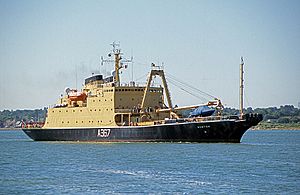RMAS Newton (A367) facts for kids
class="infobox " style="float: right; clear: right; width: 315px; border-spacing: 2px; text-align: left; font-size: 90%;"
| colspan="2" style="text-align: center; font-size: 90%; line-height: 1.5em;" | 
|}
The RMAS Newton was a special ship used for exploring the ocean. It was mainly a research vessel, which means it helped scientists learn more about the underwater world. This ship was also able to lay down some cables on the seafloor. Its first job was to test how sound travels underwater, which is called sonar propagation trials.
Contents
| History | |
|---|---|
| Name |
|
| Namesake | Isaac Newton |
| Owner |
|
| Builder | Scott Lithgow |
| Yard number | 739 |
| Launched | 25 June 1975 |
| Commissioned | 18 June 1976 |
| Identification |
|
| Fate | Scrapped 2012 |
| General characteristics | |
| Type | Research vessel |
| Displacement | 4,510 t (4,440 long tons; 4,970 short tons) |
| Length | 99 m (324 ft 10 in) |
| Beam | 16 m (52 ft 6 in) |
| Draught | 6 m (19 ft 8 in) |
| Propulsion | Diesel-electric |
| Speed | 13.5 kn (25.0 km/h; 15.5 mph) |
The Newton's Journey: From Building to Retirement
The RMAS Newton was built in Greenock, Scotland, at a place called Scott Lithgow Ltd. This shipyard was known for making many different types of vessels.
How the Ship Moved
The Newton had a special way of moving. It used three powerful diesel engines, each with 1450 horsepower. These engines didn't directly turn the propeller. Instead, they powered generators, which then created electricity. This electricity was used to run the ship's single propeller and all its other electrical systems. This setup is called "diesel-electric" propulsion.
With this power, the ship could travel at a speed of 13.5 knots. To help it steer easily, especially at slow speeds, it had a special rudder and a "bow thruster." A bow thruster is like a small propeller at the front of the ship that pushes water sideways, helping the ship move left or right without needing to go forward or backward.
Key Dates for the Newton
The ship was officially launched into the water on June 25, 1975. It took almost a year after that for it to be completely ready for service. The Newton began its work on June 18, 1976.
Upgrades and New Jobs
In the year 2000, the Newton received a big upgrade. Its old engines were replaced with newer, more efficient ones. At the same time, the equipment it used for laying cables was removed. After this, the ship took on new roles. It became a training and support vessel for special forces, helping them practice and carry out their missions.
The ship had another update in 2005 at a place called Birkenhead.
Changing Hands and Final Days
On April 1, 2008, the Newton was taken over by a company called Serco. They operated the ship for about two years. In 2010, a new ship called SD Victoria took its place.
Finally, in 2012, the RMAS Newton was sent to Ghent to be taken apart and recycled. This is called scrapping a ship.

